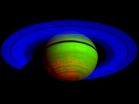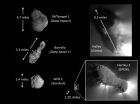(Press-News.org) The Halpin Foundation and the American Society of Nephrology (ASN) proudly highlight the research advances in membranous nephropathy made possible by The Halpin Foundation-ASN Research Grant, created to help young faculty develop independent research careers. This award provides recipients transition funding toward successful application for an NIH RO1 grant.
Elena Torban, PhD (McGill University Faculty of Medicine), the 2008 recipient of The Halpin Foundation-ASN Research Grant, recently explained, "The generous financial two-year support provided by The Halpin Foundation has enabled us to conduct a successful experimental program demonstrating for the first time that podocyte architecture is indeed regulated by the PCP pathway. We also showed that the podocyte-specific protein, nephrin, is linked to proteins of the PCP network. This finding establishes a mechanism whereby the PCP pathway regulates nephrin-dependent organization of foot processes."
The 2009 recipient of The Halpin Foundation Laurence H. Beck, Jr., MD, PhD wrote of the grant, "The funding provided by the Halpin Foundation has been instrumental in allowing my research to take root and grow. The research award has permitted me to spend the majority of these two years in the laboratory, performing experiments and helping to train young scientists and fellows conduct similar lines of inquiry. The fruits of this research should soon allow me to successfully apply for individual federal funding. Their ongoing interactions with leaders in this field on a national and international level have been enormously helpful for me in terms of forming productive collaborations to move this research forward. I will always be grateful for this support at such a critical time in the career of a young physician-scientist."
Dr. Beck and several colleagues will also participate in a Clinical Nephrology Conference (CNC) during Renal Week entitled, "Membranous Nephropathy" on Friday, November 19 from 10:30 am – 12:30 pm in Korbel 2A/3A of the Colorado Convention Center in Denver, CO. The session, "The Human Membranous Antibody: Mechanism and Monitoring" is a way to highlight research advances and stimulate investigations regarding membranous nephropathy.
The Halpin Foundation has dedicated itself to the study of membranous nephropathy since 1989, after the Halpins' 14-year-old son was diagnosed with this rare disorder. To advance research of the disorder and its symptoms, including loss of protein in the urine and a progressive decline in renal function, The Halpin Foundation partnered with the American Society of Nephrology (ASN) to promote research relevant to membranous nephropathy in 2004.
The foundation is committed to advancing the medical community's understanding of membranous nephropathy, including whether there is a hereditary predisposition to the disease. In addition, The Halpin Foundation works to raise awareness of membranous nephropathy in the scientific and lay communities.
"We are grateful to The Halpin Foundation for helping us fund new investigators interested in studying this disease to answer the many unanswered questions surrounding membranous nephropathy and nephrotic syndrome, said ASN's President, Sharon Anderson, MD, FASN.
Joan Halpin, President of the Halpin Foundation, is hopeful this program will "attract a diverse audience that will be encouraged to devote time and intellect to the consideration of the pathogenesis and therapy for this disorder."
###
ASN Renal Week 2010, the largest nephrology meeting of its kind, will provide a forum for 13,000 professionals to discuss the latest findings in renal research and engage in educational sessions related to advances in the care of patients with kidney and related disorders. Renal Week 2010 will take place November 16 – November 21 at the Colorado Convention Center in Denver, CO.
The content of this article does not reflect the views or opinions of The American Society of Nephrology (ASN). Responsibility for the information and views expressed therein lies entirely with the author(s). ASN does not offer medical advice. All content in ASN publications is for informational purposes only, and is not intended to cover all possible uses, directions, precautions, drug interactions, or adverse effects. This content should not be used during a medical emergency or for the diagnosis or treatment of any medical condition. Please consult your doctor or other qualified health care provider if you have any questions about a medical condition, or before taking any drug, changing your diet or commencing or discontinuing any course of treatment. Do not ignore or delay obtaining professional medical advice because of information accessed through ASN. Call 911 or your doctor for all medical emergencies.
Founded in 1966, the American Society of Nephrology (ASN) is the world's largest professional society devoted to the study of kidney disease. Comprised of 11,000 physicians and scientists, ASN continues to promote expert patient care, to advance medical research, and to educate the renal community. ASN also informs policymakers about issues of importance to kidney doctors and their patients. ASN funds research, and through its world-renowned meetings and first-class publications, disseminates information and educational tools that empower physicians.
Putting the spotlight on membranous nephropathy
2010-11-11
ELSE PRESS RELEASES FROM THIS DATE:
Team colors on cans change perceptions of alcohol risks, MU study finds
2010-11-11
COLUMBIA, Mo. ¬— Underage and heavy drinking on college campuses continue to be issues for college administrators. While some campuses, such as the University of Missouri, have made strides in efforts to reduce heavy drinking on campus, administrators are continually trying to educate students about the risks of excessive drinking. Now, two MU psychologists have found that students who viewed images of beer cans packaged and displayed in university colors believed that drinking beer was less dangerous than those students who saw images of regular beer cans.
"In this research, ...
University of Minnesota leads team in discovery of novel type of magnetic wave
2010-11-11
A team of international researchers led by physicists in the University of Minnesota's College of Science and Engineering have made a significant breakthrough in an effort to understand the phenomenon of high-temperature superconductivity in complex copper-oxides—one of the most studied scientific topics in history.
The University of Minnesota researchers and their international colleagues from Germany, France and China report the discovery of a novel type of magnetic wave involving oxygen atoms. The new findings could have implications for improving superconducting ...
NIH scientists unveil mechanisms of immune reconstitution inflammatory syndrome
2010-11-11
WHAT:
Newly published research by scientists at the National Institute of Allergy and Infectious Diseases, part of the National Institutes of Health, sheds light on a poorly understood, acute illness called Immune Reconstitution Inflammatory Syndrome (IRIS) that develops in some HIV-infected individuals soon after they begin antiretroviral therapy.
IRIS affects certain HIV-infected individuals whose immune systems are heavily damaged by the virus and who have a treated or undiagnosed AIDS-associated infection. When these individuals start antiretroviral therapy and ...
Cassini's CIRS reveals Saturn is on a cosmic dimmer switch
2010-11-11
Like a cosmic light bulb on a dimmer switch, Saturn emitted gradually less energy each year from 2005 to 2009, according to observations by NASA's Cassini spacecraft.
But unlike an ordinary bulb, Saturn's southern hemisphere consistently emitted more energy than its northern one. On top of that, energy levels changed with the seasons and differed from the last time a spacecraft visited in the early 1980s. These never-before-seen trends came from an analysis of comprehensive data from the Composite Infrared Spectrometer (CIRS), an instrument built by NASA's Goddard Space ...
Primordial dry ice fuels comet jets
2010-11-11
COLLEGE PARK, Md. – One of the biggest comet findings coming out of the amazing images and data taken by the University of Maryland-led EPOXI mission as it zipped past comet Hartley 2 last week is that dry ice is the 'jet' fuel for this comet and perhaps many others.
Images from the flyby show spectacular jets of gas and particles bursting from many distinct spots on the surface of the comet. This is the first time images of a comet have been sharp enough to allow scientists to link jets of dust and gas with specific surface features. Analysis of the spectral signatures ...
Pleasurable behaviors reduce stress via brain pathways, research shows
2010-11-11
CINCINNATI—Whether it's food or sex, pleasurable activity provides more than just pleasure, University of Cincinnati (UC) researchers say. It actually reduces stress by inhibiting anxiety responses in the brain.
The findings were published online Nov. 8, 2010, ahead of print in PNAS, the official journal of the National Academy of Sciences.
Experiments designed by Yvonne Ulrich-Lai, PhD, research assistant professor, James Herman, PhD, director of the Laboratory of Stress Neurobiology and professor of psychiatry and behavioral neuroscience at UC, and colleagues also ...
Economists reveal factors that help poor people lift themselves out of poverty
2010-11-11
What factors contribute to poor people in developing countries lifting themselves out of poverty?
A paper by economists Anan Pawasutipaisit of Thammasat University and Robert M. Townsend of MIT provides important insights into what kinds of households might be most effective at moving themselves out of poverty and how they are able do it.
The paper, "Wealth Accumulation and Factors Accounting for Success" appears in the current issue of the Journal of Econometrics. It suggests that poor people who skillfully manage their assets are especially successful in improving ...
Noninvasive brain stimulation helps improve motor function in stroke patients
2010-11-11
BOSTON -- A noninvasive electric stimulation technique administered to both sides of the brain can help stroke patients who have lost motor skills in their hands and arms, according to a new study led by researchers at Beth Israel Deaconess Medical Center (BIDMC).
Described in today's Online Issue of the journal Neurology, the findings showed that stroke patients who received bihemispheric transcranial direct current stimulation (tDCS) coupled with a regimen of physical and occupational therapy had a three-fold greater improvement in motor function compared with patients ...
JDRF clinical panel recommends next steps for artificial pancreas clinical testing
2010-11-11
Diabetes experts at a meeting convened by the U.S. Food and Drug Administration (FDA) and the National Institutes of Health (NIH) took the next step in advancing efforts toward the development of an artificial pancreas: putting forth clinical recommendations to ensure the safe and effective testing of artificial pancreas technology in real-life situations. We are pleased at today's meeting there was a strong consensus among leading clinicians, researchers and industry leaders regarding the path toward outpatient studies for both low-glucose suspend and artificial pancreas ...
Win some, lose some: U-M expert provides reapportionment projections
2010-11-11
ANN ARBOR, Mich.---Before the U.S. Census Bureau releases its official state-level population counts to Congress on Dec. 31, a University of Michigan demographer offers projections of likely state winners and losers.
But she also cautions that there are likely to be plenty of surprises.
According to Lisa Neidert, data services manager at the U-M Institute for Social Research (ISR) Population Studies Center, the most likely state winners---based on July 2009 population estimates from the Census Bureau---are Texas (3 seats), and Arizona, Florida, Georgia, Nevada, South ...

